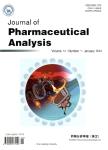Design and preparation of a new multi-targeted drug delivery system using multifunctional nanoparticles for co-delivery of siRNA and paclitaxel
Design and preparation of a new multi-targeted drug delivery system using multifunctional nanoparticles for co-delivery of siRNA and paclitaxel作者机构:Department of Agronomy and Plant BreedingFaculty of Agriculture and Natural ResourcesUniversity of Mohaghegh ArdabiliArdabilIran Biotechnology Research CenterTabriz University of Medical SciencesTabrizIran Department of PharmaceuticsSchool of PharmacyArdabil University of Medical SciencesArdabilIran Department of Medicinal ChemistryFaculty of PharmacyTabriz University of Medical SciencesTabrizIran
出 版 物:《Journal of Pharmaceutical Analysis》 (药物分析学报(英文版))
年 卷 期:2021年第11卷第2期
页 面:163-173页
核心收录:
学科分类:100702[医学-药剂学] 1007[医学-药学(可授医学、理学学位)] 1006[医学-中西医结合] 100602[医学-中西医结合临床] 10[医学]
基 金:supported by the Deputy Research and Technology Ardabil University of Medical Sciences
主 题:Paclitaxel siRNA Targeted drug delivery Magnetic nanoparticles Polymeric drug delivery
摘 要:Drug resistance is a great challenge in cancer therapy using chemotherapeutic agents. Administration of these drugs with siRNA is an efficacious strategy in this battle. Here, the present study tried to incorporate siRNA and paclitaxel(PTX) simultaneously into a novel nanocarrier. The selectivity of carrier to target cancer tissues was optimized through conjugation of folic acid(FA) and glucose(Glu) onto its surface. The structure of nanocarrier was formed from ternary magnetic copolymers based on FeCopolyethyleneimine(FeCo-PEI) nanoparticles and polylactic acid-polyethylene glycol(PLA-PEG) gene delivery system. Biocompatibility of FeCo-PEI-PLA-PEG-FA(NPsA), FeCo-PEI-PLA-PEG-Glu(NPsB) and FeCo-PEI-PLA-PEG-FA/Glu(NPsAB) nanoparticles and also influence of PTX-loaded nanoparticles on in vitro cytotoxicity were examined using MTT assay. Besides, siRNA-FAM internalization was investigated by fluorescence microscopy. The results showed the blank nanoparticles were significantly less cytotoxic at various concentrations. Meanwhile, siRNA-FAM/PTX encapsulated nanoparticles exhibited significant anticancer activity against MCF-7 and BT-474 cell lines. NPsAB/siRNA/PTX nanoparticles showed greater effects on MCF-7 and BT-474 cells viability than NPsA/siRNA/PTX and NPsB/siRNA/***, they induced significantly higher anticancer effects on cancer cells compared with NPsA/siRNA/PTX and NPsB/siRNA/PTX due to their multi-targeted properties using FA and Glu. We concluded that NPsAB nanoparticles have a great potential for co-delivery of both drugs and genes for use in gene therapy and chemotherapy.



